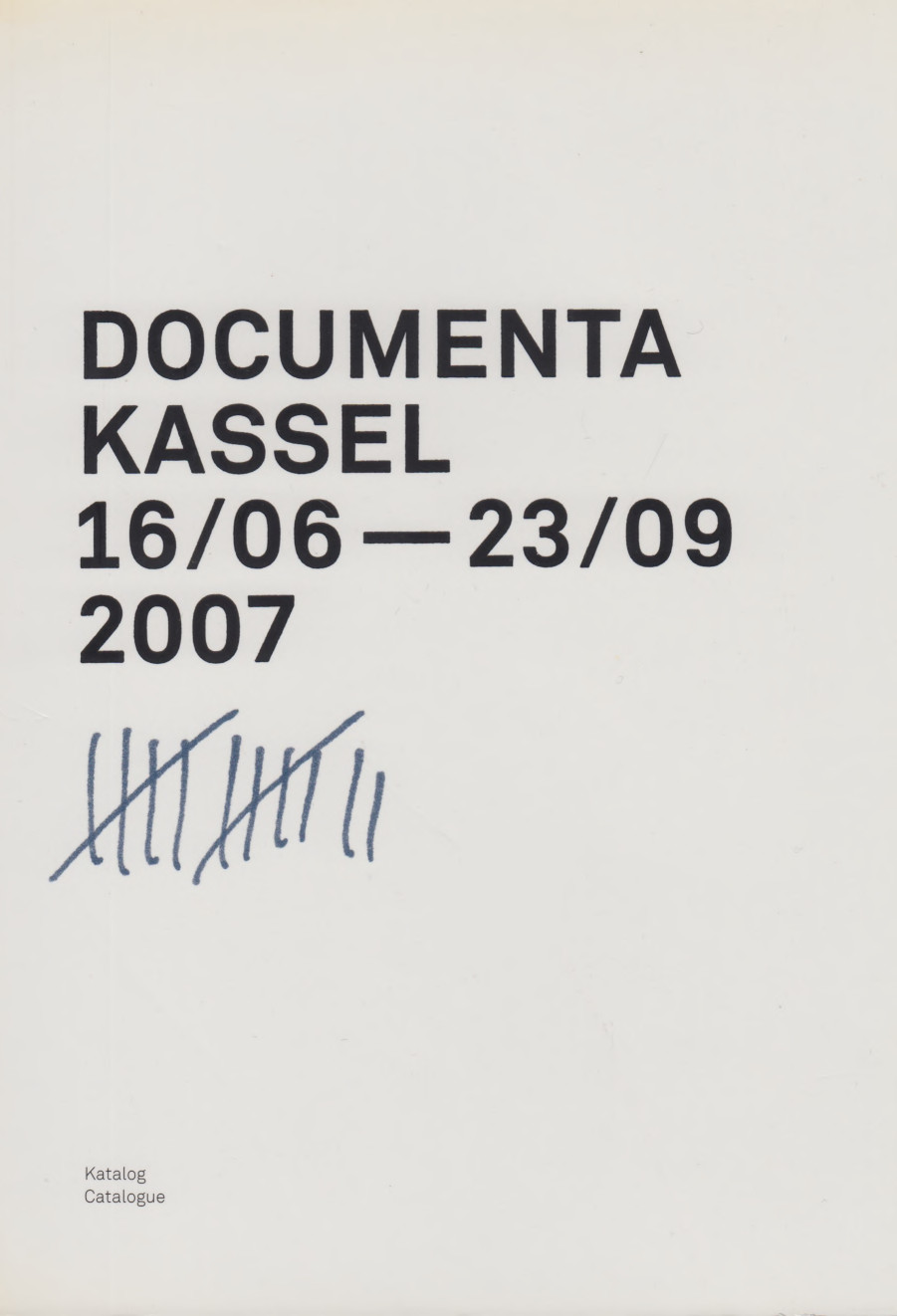documenta 12 (2007) [German/English]
Filed under catalogue | Tags: · art, contemporary art, form, migration

“For the first time in the history of the documenta, the major event in Kassel was organized under the direction of a couple: Roger M. Buergel as the designated art director and Ruth Noack as curator. They served only “unofficially” as a two-member directorial team, however, as the documenta statutes do not allow for the possibility of two co-directors. Together, they developed a clearly defined programmatic concept under the banner of “The Migration of Forms.” What that meant was that, over the course of human history, visual culture has had only a limited number of basic forms with which to work—forms that have been used in different contexts and with different conceptual focuses throughout the history of art. Buergel/Noack pointed out that “contemporary does not mean that the works originated yesterday. They must be meaningful for people today. Documenta 12 is concerned with both historical lines of development in art and unexpected concurrences.” In order to bring these “unexpected concurrences” to light, relationships were established between works of art from different decades and cultures in which similar formal patterns have emerged—a process that has led to a “migration” of aesthetic forms across temporal and cultural boundaries culminating in the art of our postmodern world. This formalism was emphasized in the Neue Galerie by walls painted different colors. In turn, this focus on the phenomenon of migration resulted in the selection of a high percentage of artists from Africa, Asia, and Eastern Europe. New to the program was the inclusion of old art, from fourteenthcentury Persian miniatures to global art from recent decades. Artists already long since recognized in their own homelands, such as Nasreen Mohamedi, for example, were not the only ones presented to a broad public in Germany for the first time. The works of several exemplary artists—John McCracken, Kerry James Marshall, Charlotte Poseneske, and Gerwald Rockenschaub—also migrated through all exhibition venues.” (Source)
Publisher Taschen, Cologne, 2007
ISBN 9783836500524, 3836500523
415 pages
via x
PDF (148 MB, no OCR)
Comment (0)Glossary of Common Knowledge (2017)
Filed under book | Tags: · art theory, commons, contemporary art, geopolitics, glossary, history, politics, subjectivation, subjectivity, theory

The Glossary of Common Knowledge is a research project by MG+MSUM, Ljubljana, in the frame of L’Internationale, aiming to negotiate various positions, contexts and local narratives about contemporary art. The glossary entries were produced through six seminars (2014-17), each focusing on one selected referential field: historicization, subjectivization, geo-politics, other institutionality, and commons. The resulting website now functions as an open platform accepting new contributions.
Fields and terms:
Historicization: archive, constellation, emancipation, temporally embodied sound, estrangement, heterochronia, humanism, intuition, pathological fracture, phantom (pain), reconstruction, self-historicization, temporalities, tendencies in art, the contemporary.
Subjectivization: creleasure, dancing as insurrectional practice, decolonize, evidence, fragility, interest, kapwa, loser, over-identification, radical imagination, self-determination, self-representation, on subjectivization, the subject, travesti, unrest.
Geo-politics: agitational visual language, alignment, catastrophe, eurasia, event, global resistance, institutional geopolitical strategies, migrancy, non-aligned movement, pandemic, postsocialism, south, tudigong, god of the land, white space.
Constituencies: agency, autonomy, biotope, bureaucratisation, collaboration / co-labour, construction, the continuity-form and counter-continuity, de-professionalization, intervenor, labour, ñande / ore, the eternal network / la fête permanente, the rest is missing.
Commons: to baffle, basic income, the brotherhood & unity highway, constituent power of the common, corrected slogan, data asymmetry , friendship, heterotopian homonymy, institution, noosphere, palimpsest, rog, self-management, solidarity, theft.
Other institutionality: a residual, adab, alternating, conspiratory institutions?, dark room, deviant, family, global crowd, interdependence, lobbying, reflexive / reflexivity, stultifera navis, the sustainable museum, the art hypothesis, translation.
Curated by Zdenka Badovinac, Bojana Piškur and Jesús Carrillo (MNCARS) in collaboration with L’Internationale, et al
Publisher MG+MSUM, Ljubljana, 2017
HTML (on the website of MG+MSUM)
HTML (on the website of L’Internationale, added on 2020-4-12)
Seminar recordings structured by terms discussed
Seth Price: Fuck Seth Price: A Novel (2015)
Filed under fiction | Tags: · art, contemporary art, painting

“In the course of a gripping, headlong narrative, Price’s unnamed protagonist moves in and out of contemporary non-spaces on a confounding and enigmatic quest, all the while meditating on art in a broad sense: painting, sculpture, film, architecture, literature, and poetry. From boutique hotels and highway bridges to PC terminals and off-ramps; from Kanye West and Jeff Koons to George Bush and Patricia Highsmith; from the playground to the internet to the mirror, Price’s hybrid of fiction, essay, and memoir gets to the questions of how we live now.”
Publisher Leopard, New York, 2015
ISBN 9780981546834, 0981546838
124 pages
via author
Reviews: Benjamin Lord (Art Book Rev), Liz Glass (CAA), Ross Simonini (Art in America).
Comment (0)
